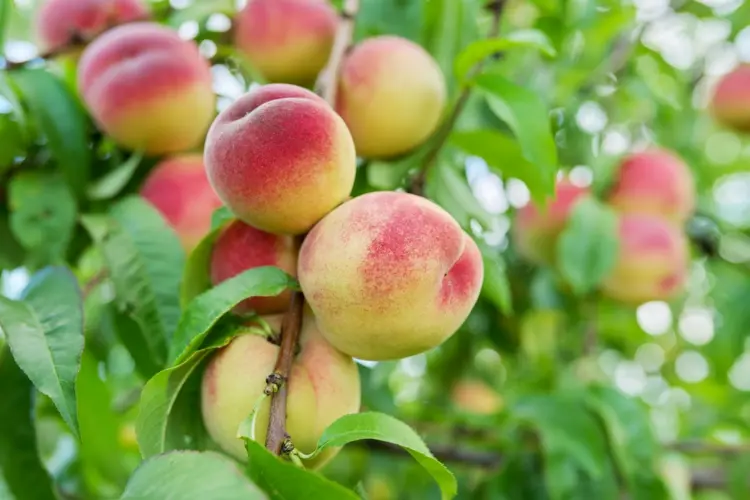One of the most common diseases in fruit trees is the so-called curling disease. As the name suggests, it is manifested by the curling of the leaves. What is leaf curl on fruit trees, how can it be prevented or treated? We show you how to spot leaf curl on the peach tree and what you can do about it as soon as you notice that the peach leaves are curling.
Peach leaves curl: When the fruit tree suffers from curling disease
Why do the leaves of the peach, and later the fruits of the fruit tree, curl? What causes this growth problem? This is a fungal disease, and it is a fairly stubborn fungus. While he is not difficult to fight, anyone who thinks that the cold winter will be the solution to the problem is wrong. The Taphrina deformans, as the fungus is called, hibernates without any problems on the shoots, scales of the buds and also on the tree bark. you act not in good time, so it causes damage every year. In addition to peaches, nectarines, apricots and plums are usually affected.
How do you recognize leaf disease?
The peach leaves curl, not only did we mention that, but you’ve probably noticed it already. But there are also other signs: Sometimes the leaves turn red or yellowish-white. It is not uncommon for the tree leaves to dry up and then fall off. The peach tree then forms new shoots with leaves that appear to be healthy again. This is also Eanother reason why many believe the infection may have passed on its own. But appearances are deceptive, because the following year the problem repeats itself.
Peach leaves curl: when will the disease break out (again)?
Not only the means you use are important for combating it, but also the point in time. In winter, the fungus is dormant due to the cold. However, when the temperatures rise again, his time will come and he will infect the peach tree again. Since 10 degrees above freezing is perfectly sufficient for him, this happens quite early in the year. Infection occurs through the buds as they swell and moisture such as rain washes the spores into these delicate parts of the plant.
It is therefore necessary to anticipate this. It is worth treating the trees as early as the end of January if you know about the tree fungus from the previous year. At the latest, however, just before the buds open, you should act. This is also a good idea as a preventive measure. You can buy a peach curl spray or you can make your own and spray regularly over a period of time. In any case, the anti-frizz remedy should be biological and harmless. For example, copper is very effective and popular for peach curl control.
The peach leaves are curling and you want to do something? Here you will find a few suitable home remedies for frizz.
What else should one do if the peach tree leaves suffer from curling disease?

Treating peach curl with sprays is a better option for winter or spring. However, if you have previously noticed an infection on your trees, you should not wait until then, but dare to take a first step to combat it and that is to cut off infected shoots. You then dispose of these branches in the household waste (never on the compost) to reduce the amount of spores that could then overwinter on the tree. In the coming year, however, you will still have to work with sprays, because removing diseased shoots alone is by no means enough.
prevent frizz disease

To make peach tree leaf curling a thing of the past and to make it stay there, there are some preventive measures you can take to protect your fruit tree. The following care measures are important against peach curl disease:
- If the tree is already established, this is an inappropriate measure, but at least for all future peach trees you should know: Like any fungus, this one likes moisture. The site can strongly influence the humidity of the environment. So make sure you choose a location that is well ventilated (without drafts). This means, for example, avoiding areas in front of walls and walls. This allows the tree to dry faster after rain or dew and makes things rather uncomfortable for the fungus.
- Regular cuts for thinning also enable better ventilation within the tree crown and should not be neglected for the same reasons. If you grow the branches and twigs too dense, moisture builds up inside.
- The following applies to all diseases and pests: the stronger the plant, the less susceptible it is. So don’t neglect them nutrient supply and for this purpose it is best to use slow-release organic fertilizers in order to be able to reduce the frequency of administration and save time.
- Examine regularly pests, which can transfer the spores from other infected plants to your peach tree. Aphids in particular are known to transmit germs and should be combated as quickly as possible.
Not to be confused with the peach louse

The peach tree leaves curl up when they are infested with the so-called green peach aphid. Visually, this is very reminiscent of frizz. So before you resort to remedies to combat peach leaf curl, you should play it safe and take a closer look at the leaves. The lice can not only dry up the leaves, but also transmit viruses. Therefore, you should also act quickly in this case and inject the peach, but with appropriate means.
